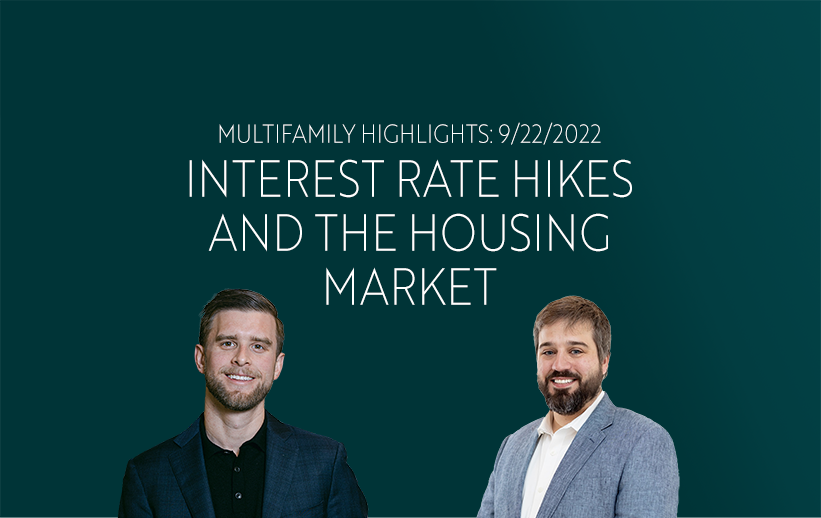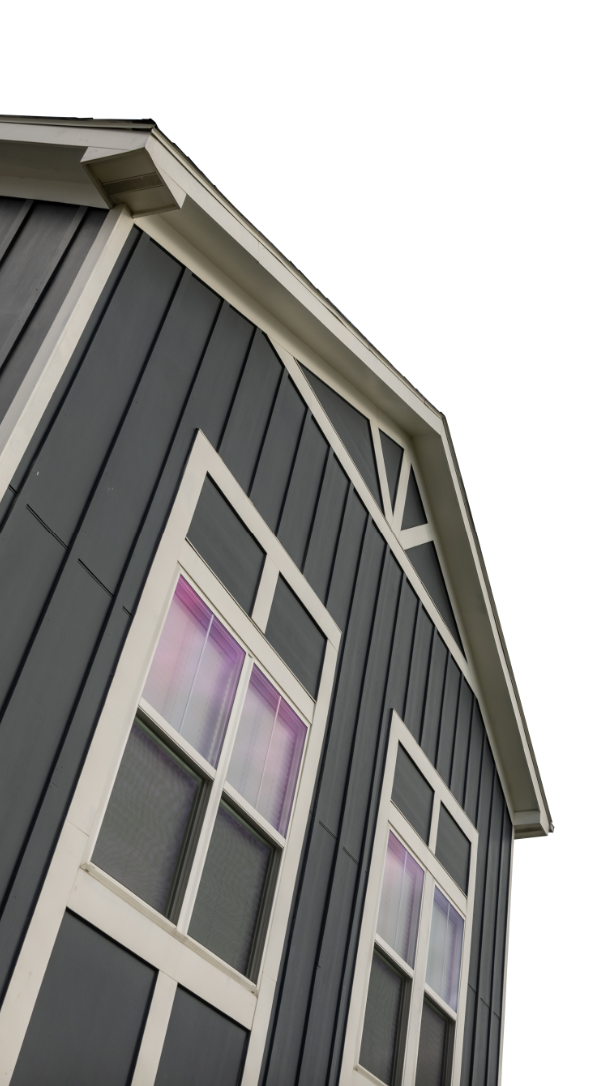
Multifamily Highlights, 9/22/2022: Rate Hikes and the Housing Market
The Federal Reserve’s 0.75% increase in the federal funds rate places even more pressure on the economy, and as home prices show consistent signs of a cooldown, multifamily investors are watching the market closely. While single-family home prices are correlated with multifamily rents, apartment rent growth has not seen the same declines, partly because average monthly payments for single-family homes have been consistently above the price of rentals, providing some cushion against the interest-rate-related volatility we are currently facing.
Investor’s Business Daily: “Federal Reserve Raises Interest Rates by 0.75 Percentage Point” – https://www.investors.com/news/economy/federal-reserve-expects-key-rate-to-peak-at-4-point-6-percent-dow-jones-falls/
- The expected came true. 0.75% increase in the federal funds rate.
- When the inflation numbers came in last week at 0.1%, the expectation started to lean a little more closely toward a full 1% rate hike, but not really.
- A 75 bps increase remains significant. The Fed’s not just keeping up the pressure, it continues to tighten the nozzle, so to speak. Monetary tightening continues as well–the Federal Reserve is reducing its asset purchases and reducing liquidity in the market.
- The nozzle is tightening, the water pressure is going down, but inflation has not yet fully relented.
- I was trying to construct a water balloon metaphor with this one, but it was not perfect.
- Core inflation’s increase also would maybe suggest that the Fed is on the right track. Core inflation, which does not factor in food and energy prices (this includes gas prices), according to last week’s CPI numbers, was up 0.6%, which is not sustainable. That would get us to 7.2% inflation spread over the course of a year.
Redfin: “Rental Market Tracker, August 2022” – https://www.redfin.com/news/redfin-rental-report-august-2022/
- Rent growth will likely slow further as the Federal Reserve continues to raise interest rates. Higher interest rates impact the rental market because they put a damper on spending power in the economy as a whole, including renters’ budgets,” said Redfin Deputy Chief Economist Taylor Marr. ”Growth in rents is also likely to be slowed by a boost in rental supply. There are nearly a million rental units under construction that will hit the market in the coming months and years.”
- The first point is valid, I think when you think about things that effect the economy broadly, those are going to have an effect on the rental market.
- The second point is a little more up in the air and definitely is market-dependent. I’ve seen completion projections revised downward as we progress through the year, so new supply may take longer to arrive, and this is a market-by-market phenomenon such that each market’s performance is going to be different.
- Year-over-year increase is at 11%, down from a peak of 19% YoY this March.
- Month-over-month, rents increased by 0.4%, which is even with RealPage’s and CoStar’s estimates, and above the 0.1% monthly growth measured by Yardi Matrix.
- We spoke last week about how RealPage reported August 2022 rent growth even with August 2021, so rent growth on top of rent growth, in this compounding push upwards. Redfin actually records higher YoY rent growth for August 2022 (11%) than we had in August 2021.
- We’re normalizing from this elevated period of growth, but the rate of this normalization is slowing. We could see a full two years, from June 2021 until maybe June of next year, where rent growth is above 5%.
- The market information is interesting but a little more volatile-seeming than other reports. Both Redfin and last week’s CoStar/Apartments.com report measured asking rents, so here are some numbers:
- Indianapolis is number three in year-over-year rent growth for Redfin, behind Cincinnati and Pittsburgh.
- Indianapolis Redfin: 21%, CoStar: 10.1%
- Cincinnati Redfin: 26%, CoStar: 9%
- Pittsburgh Redfin: 22%, CoStar didn’t have the numbers DANG IT
- Markets with rent declines are:
- Milwaukee: Redfin -15%, CoStar no numbers
- Minneapolis: Redfin -7%, CoStar 2.8% (positive)
- Baltimore: Refin -1%, CoStar 4.8% (positive)
- Indianapolis is number three in year-over-year rent growth for Redfin, behind Cincinnati and Pittsburgh.
Zillow: “August 2022 Market Report” – https://www.zillow.com/research/august-2022-market-report-31425/
- The typical home value fell 0.3% from July, the largest monthly decrease since 2011
- Listings now take 16 days to go pending, up from 10 days at this time last year
- Total inventory ticked up slightly, driven by lingering homes, as new listings drop off
- Looking at the chart, you can see monthly mortgage payments have more or less quote unquote levelled off, but at a very elevated level. They’re up 58.8% year-over-year. That’s not sustainable.
- Another thing of note: Less people are selling. Some are holding off, some are, according to a recent WSJ article, choosing to rent out their homes instead of selling them.
- This is a softening market. Year-over-year home prices have gone down slightly for two months in a row. The month-over-month numbers show a significant reduction in home values and some real drama. This is a little more persuasive to me than before.
- A bonus: Zillow does have some rental market information, finding that rents went up 12.3% year over year in August, even with last year’s 12.3% increase
Integra Realty Resources: “2022 Mid-Year Viewpoint Summary” – https://www.irr.com/news/just-released-irr-s-mid-year-2022-viewpoint-local-market-reports-19874
- The idea that apartment rents follow home prices and follow housing prices more generally is pretty robust and was proven out in the pandemic.
- It’s tougher, then to find an article from a multifamily authority that highlights how falling home prices could lead to falling apartment rents.
- This report from Integra Realty Resources, which goes through the office and retail markets in addition to multifamily, gets right to the point when it comes to falling apartment rents.
- I’m not going to flinch from this or try to deflect the underlying thesis because if home prices fall consistently, which is pretty likely at this point considering the continued rate hikes, we’ll see an effect in the apartment market.
- Even so, rent prices are higher than home payments, and that gives us a little bit of a cushion.
- (Quote from GlobeSt article [link] on this summary)
Fortune (via Yahoo Finance): “We’re Entering the Next Stage of the Housing Market” – https://www.yahoo.com/video/were-entering-next-stage-housing-214606513.html
- Three things to expect:
- Price correction spreading, with falling prices through 2023.
- This is pretty reasonably considering that we’re heading into the winter time, and this article cites a Moody’s Analytics report expecting a 5% price correction, all told.
- Housing downturn spreads beyond housing
- This is similar to the idea that things that affect the whole of the economy are going to affect the housing (and the multifamily) markets.
- I think that Fortune overplays this just a little bit. As easy as it is to fall back into the line of thinking that we’re facing a huge housing crisis like the late 2000s, I don’t think that’s in the cards. I think that the huge factor driving this recduced housing demand is the raise in interest rates from the fed, and that does not have to be a long-term thing. J Powell, if you can hear this , rising interest rates do not have to be a long-term thing.
- Sellers are calling timeout:
- There is a growing amount of sellers holding off, because who wants to sell when you have to buy less house for more money given the higher mortgage payments you’ll have to pay?
- When it gets to the point where sellers have to sell, we might see a bigger increase in inventory.
- A timeout implies that this is a temporary situation, and with more inventory, that would really make a dent in housing prices.
- Ultimately, this redounds to the multifamily market because there is a link between home and apartment prices. That being said, there is a way to go before we get to parity.
- Right now, home payments are above rents. That’s a cushion, but that could go away soon if home prices continue to fall.
